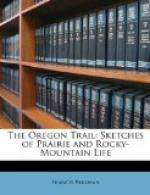Again we found the same execrable barren prairie offering no clew by which to guide our way. As we drew near the hills an opening appeared, through which the Indians must have gone if they had passed that way at all. Slowly we began to ascend it. I felt the most dreary forebodings of ill success, when on looking round I could discover neither dent of hoof, nor footprint, nor trace of lodge-pole, though the passage was encumbered by the ghastly skulls of buffalo. We heard thunder muttering; a storm was coming on.
As we gained the top of the gap, the prospect beyond began to disclose itself. First, we saw a long dark line of ragged clouds upon the horizon, while above them rose the peak of the Medicine-Bow, the vanguard of the Rocky Mountains; then little by little the plain came into view, a vast green uniformity, forlorn and tenantless, though Laramie Creek glistened in a waving line over its surface, without a bush or a tree upon its banks. As yet, the round projecting shoulder of a hill intercepted a part of the view. I rode in advance, when suddenly I could distinguish a few dark spots on the prairie, along the bank of the stream.
“Buffalo!” said I. Then a sudden hope flashed upon me, and eagerly and anxiously I looked again.
“Horses!” exclaimed Raymond, with a tremendous oath, lashing his mule forward as he spoke. More and more of the plain disclosed itself, and in rapid succession more and more horses appeared, scattered along the river bank, or feeding in bands over the prairie. Then, suddenly, standing in a circle by the stream, swarming with their savage inhabitants, we saw rising before us the tall lodges of the Ogallalla. Never did the heart of wanderer more gladden at the sight of home than did mine at the sight of those wild habitations!
CHAPTER XIV
THE OGALLALLA VILLAGE
Such a narrative as this is hardly the place for portraying the mental features of the Indians. The same picture, slightly changed in shade and coloring, would serve with very few exceptions for all the tribes that lie north of the Mexican territories. But with this striking similarity in their modes of thought, the tribes of the lake and ocean shores, of the forests and of the plains, differ greatly in their manner of life. Having been domesticated for several weeks among one of the wildest of the wild hordes that roam over the remote prairies, I had extraordinary opportunities of observing them, and I flatter myself that a faithful




